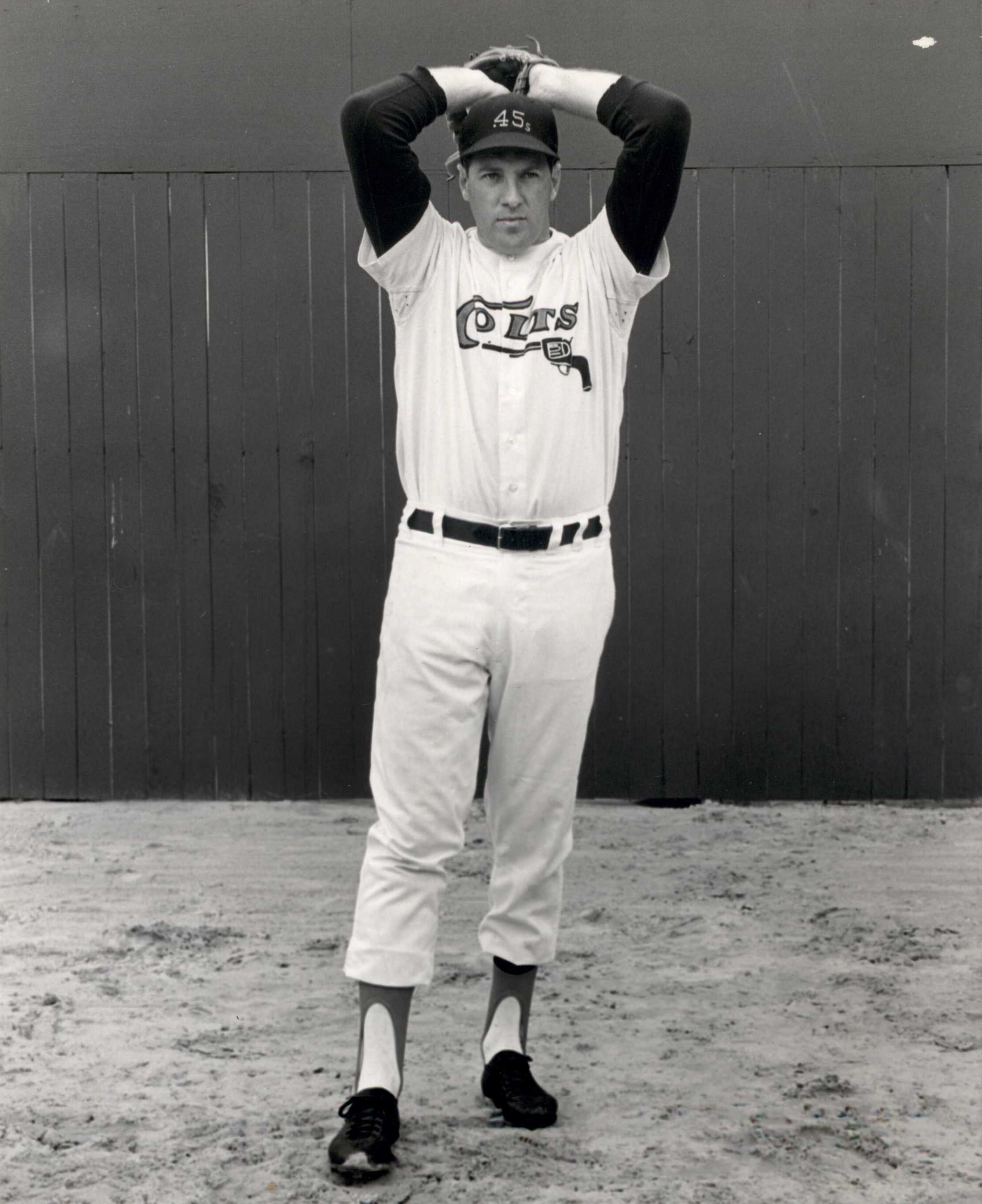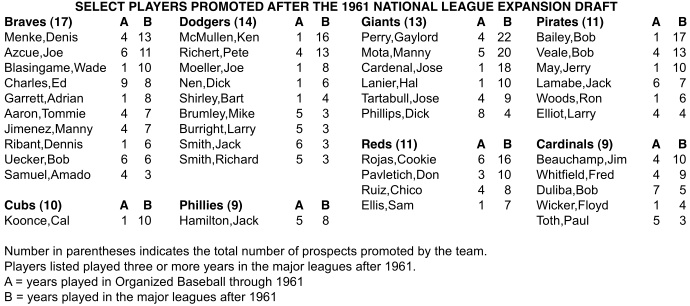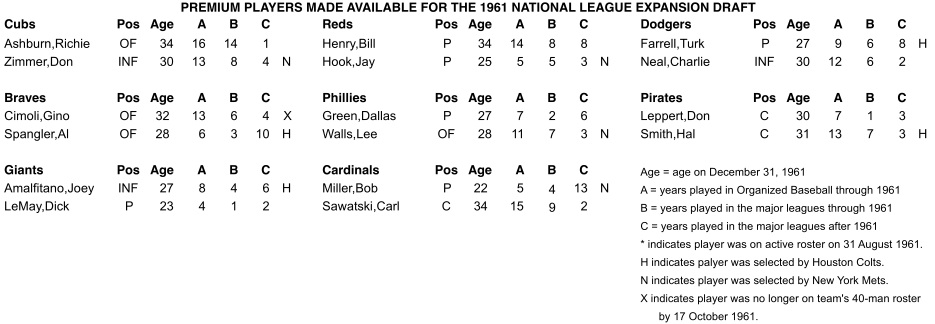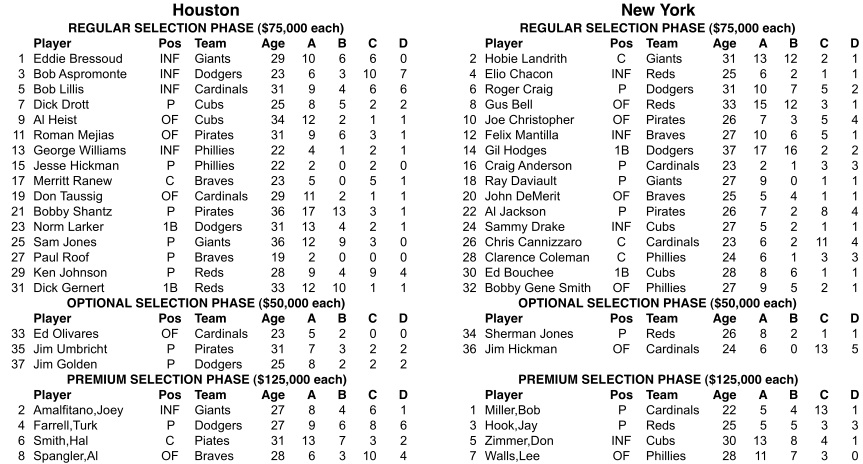The Colt .45s and the 1961 Expansion Draft
This article was written by Eric Thompson - Stephen D. Boren
This article was published in The National Pastime: Baseball in the Space Age (Houston, 2014)
 On October 10, 1961, the National League held the expansion draft to provide players for the Houston Colt .45s and the New York Mets. While the American League had held a seemingly similar expansion draft on December 14, 1960, the National League draft had the following distinctions:
On October 10, 1961, the National League held the expansion draft to provide players for the Houston Colt .45s and the New York Mets. While the American League had held a seemingly similar expansion draft on December 14, 1960, the National League draft had the following distinctions:
- It was held earlier in the year.
- There were three distinct price levels for draftable players.
- It was less cumbersome to implement.
- There were different draft selection requirements.
- It was held before the Rule 5 Draft.
As in the 1960 American League draft, the eight established National League teams were required to name 15 available players on their 40-man roster—including seven players from their 25-man roster.1 The due date for the National League lists was September 20 for the draft that would occur on the day after the 1961 World Series ended, more than two months earlier than the American League draft had taken place in 1960.
In the previous AL draft, all the players in the expansion pool were available for $75,000 each to the new teams. However, the National League draft had three prices for players: $50,000, $75,000, and $125,000. Each expansion team was required to select 16 players: two from each established team’s available player list at $75,000 (regular phase), then at most eight players, one from each established team at $50,000 (optional phase) from the players remaining. At that point, in a major departure from the AL system, each established team was to submit two additional names from their August 31 active roster: “premium players.” From this list of 16, each expansion team was required to choose four players at $125,000 each (premium phase), and no established team could lose more than one premium player.
If an expansion team purchased the maximum number of players—16 at $75,000 each, eight at $50,000 each, and four at $125,000 each—the total cost would be $2.1 million. That cost represented the team’s entry fee into the National League and was equal to the amount paid by the AL expansion teams for 28 players at $75,000 each. While these prices for players do not seem high in 2014, they were quite pricey in 1961 even after discounting the entry fee involved. The consumer price index was 29.9 in 1961, compared to 233.5 in 2013.2 Adjusting 1961-dollars to 2013-dollars at a rate of $7.81, would yield prices of $585,750, $390,500, and $976,250.3 The sale of players was a financial bonanza to each of the eight established teams.
The American League had required that each new team draft ten pitchers, followed by two catchers, six infielders, four outfielders, and then six players unrestricted by position. The NL draft did not have any position requirements. In the AL draft no established team was supposed to lose more than seven players and an expansion team could take no more than four players from any established team. Unfortunately Joe Cronin forgot about these requirements while he conducted the AL draft and the selections needed to be rearranged after the draft was seemingly over because the Tigers and Indians had lost eight players each!4 The NL draft did not make this mistake.
While these differences were significant, the most significant distinction was the date of the draft. The AL draft was held more than two months after the season ended. Thus before the 1960 American League expansion draft, the lists of available players had not been distorted by any of the following roster changes:
- Retirements (e.g. Ted Williams)
- Unconditional releases
- Sale and optioning of players to minor league teams
- Promotion of prospects
- Addition of players taken in the Rule 5 Draft held on November 28
After the 1960 season ended but before the 1960 draft, the Cleveland Indians had released Jack Harshman and sold Billy Moran to the International League, the Orioles had released Jim Busby, Del Rice, and Dave Philley, the Yankees had released Jim Hegan, and the White Sox had released Bob Rush and Mike Garcia and dropped Don Ferrarese, Jake Striker, Frank Barnes, and Al Worthington.5,6 With only eight days between the end of the season and the NL draft, no roster modifications by any of the eight established National League teams had yet taken place.
The greatest inequity of the NL expansion draft was that few blue chip minor league prospects were included on the 40-man rosters. Most promoted their top minor leaguers on October 17, 1961, seven days after the draft and the last day to modify the 40-man roster before the Rule 5 and Rule 3 Drafts. These players had been exempt from the expansion draft in October and now were protected in late November as well. A partial list of these prospects appears in Table 1.7
Table 1. Select Players Promoted after the 1961 National League Expansion Draft
Meanwhile, many “deadwood” players promoted in September to be showcased for the expansion draft, but not taken, were then shuffled off the 40-man roster to make room for superior minor league talent.
The list of players made available for the NL expansion draft appears in Table 2.8
Table 2. Players Made Available for the 1961 National League Expansion Draft
(Click image to enlarge.)
The general managers in Houston and New York, Paul Richards and George Weiss, were not happy with the players made available. Richards commented, “I figured the lists of players would be bad, but they’re worse than I thought they would be.”9
Thirty of the available players were 31 or older. Nineteen had eight years or more of major league experience including many with correspondingly high salaries. Of the 120 available players, 23 were rookies who ended their baseball careers without ever appearing in a single major league game—19 additional players never played at the major league level after 1961. Twenty-one were journeyman players who had spent seven or more seasons in the minor leagues.
At the AL expansion draft there were five coin tosses, one for each position category. At the NL expansion draft there was one coin toss with the winner selecting to go first in the regular-optional phase or the premium phase. The Colts won the coin toss and elected to go first in the regular-optional phase.
The Colts decided that shortstop Ed Bressoud of the Giants was the best player available and selected him. He had been the backup to Jose Pagan and played in only 59 games the past season while hitting a mere .211. On November 26 he was traded to the Red Sox for the erratic Don Buddin, another shortstop. After 40 games in 1962, Buddin was hitting .163 and was sold to the Tigers. They did well with their second pick, Bob Aspromonte, who had a successful career with Houston. Incidentally, his brother Ken had been selected by the Senators and traded to the Angels at the draft table in the AL expansion draft.10 Their third pick was light-hitting shortstop Bob Lillis, who did have a long Houston career as a player, coach, and manager.
Fourth and fifth picks, Dick Drott and Al Heist, were both from the Cubs and were both busts. Drott was called to eight months of active military duty on November 2 and appeared in only six games.11 Heist was on the disabled list for a month, played in only 27 games, and batted only .222.12 In 1963, Drott went 2–12 in his final year in the majors. Heist was in the minors all season.
Sixth pick Roman Mejias was a power hitting success in 1962 for the Colts and became one of their most popular players. In 1962, Mejias led the team in batting, home runs, runs batted in, runs scored, hits, and stolen bases. After the season he was traded to the Red Sox for the reigning AL batting champion, Pete Runnels. Unfortunately, Runnels lost his batting eye when he joined the Houston team and was released in early 1964.
Seventh pick George Williams, like Drott, was called to active military duty soon after the draft.13 Williams played in only five September games for the Colts in 1962, played in the minors in 1963, and was sent to the Cardinals after the season. Eighth pick Jesse Hickman never played in a major league game with the Colts. It is very likely that Paul Richards mistook him for Jim Hickman, who was also available in the expansion draft. It wasn’t the first time a GM made such a mistake: The St. Louis Browns took Garvin Hamner in the 1947 minor league draft, thinking that they were selecting his brother Granny.14 Ninth pick Merritt Ranew was a backup catcher for one season, then was traded away and spent most of his career in the minors. Their 10th pick Don Taussig hit only .200 in 16 games, but the Colts received part of their investment back when the Braves drafted him in the minor league phase of the 1962 Rule 5 Draft.
Their 11th pick Bobby Shantz started three games on the mound for the Colts before being traded to the Cardinals for Carl Warwick and John Anderson on May 7, 1962. Warwick became the Colts’ regular center fielder for 1962. Since the Washington Senators had selected Shantz in the 1960 AL expansion draft, Shantz bore the distinction of being the only player selected in both drafts.15
Their 12th pick was Norm Larker, who had lost the 1960 batting title by making an out in his final plate appearance. However, he hit only .263 for the Colts and was traded after the 1962 season. Their 13th pick, Sam “Toothpick” Jones, never pitched for the Colts. Jones was quickly traded on December 1 to the Tigers for Bob Bruce and Manny Montejo. Bruce pitched in the Colts starting rotation for five years. Jones won only four games during the remainder of his career. Their 14th pick was Paul Roof, who never played major league baseball, although his brothers Phil and Gene did. Again, perhaps he was mistaken for Phil who was also in the draft.
Their 15th pick was Ken Johnson who was a decent pitcher for Houston for several seasons during his 13-year major league career. His main claim to fame was pitching a nine-inning no-hitter for the Colts on April 23, 1964, but losing the game 1–0 when he and Nellie Fox made errors in the ninth inning. Their 16th pick, Dick Gernert, hit .208 in 10 games and was quickly released on May 17, 1962.
Their 17th pick and first $50,000, optional pick was Ed Olivares. Olivares was on the disabled list during the entire 1962 season and never played again in the majors.16 Eighteenth pick Jim Umbricht pitched effectively out of the bullpen for two years before he, unfortunately, died of cancer in 1964. Nineteenth pick Jim Golden was back in the minors in 1963 and traded for Nellie Fox after that season.
Golden was the last optional pick taken in the draft because Weiss and Richards refused to spend any more money. By leaving eleven optional choices unused, the Mets saved $300,000 and the Colts $250,000 on the anticipated $2.1 million expected expenditure by each team. Both general managers intended to use that money to develop their teams: Weiss to purchase retreads at his own price, Richards to acquire and develop young talent.
At that point a representative from each established team made known the identity of their team’s two premium players. Table 3 shows the 16 premium players, two from each established team, made available for the NL expansion draft.17
Table 3. Premium Players Made Available for the 1961 National League Expansion Draft
The premium player choices were marked by the presence of three “bonus babies” from the mid-1950s. Those three, Bob L. Miller (Cardinals), Joey Amalfitano (Giants), and Jay Hook (Reds), were the first three players taken in the premium phase. Since the Mets chose first in the premium phase, Miller and Hook became Mets. The Colts took Amalfitano with their first premium pick. Their original teams actually turned a tidy profit when they received $125,000 each! On the humorous side, when Amalfitano discovered that he had been purchased for that princely sum, he said, “I’ll have to go out and get another life insurance policy. I’m worth more than I thought.”18 Amalfitano lasted only one season with Houston but enjoyed a long career as a major league coach and manager.
Their second premium pick, Dick “Turk” Farrell, was an all-star pitcher for the Colts, and was their jewel of the draft. Their third premium pick, Hal W. Smith, was their regular catcher in 1962 and their third string catcher the next season, before he was released. Their final premium pick, Al Spangler, was a regular outfielder for three seasons before being traded away. Spangler had the distinction of being the final player taken in the NL expansion draft as well as the last player to bat in an eight-team National League. The regular, optional, and premium choices made by the Colts and Mets appear in Table 4.19
Table 4. Regular, Optional, and Premium Draftees of the Colts and Mets
(Click image to enlarge.)
After the draft, Paul Richards had changed his tune. Richards was quoted, “I was frightened a week ago when I did some talking, but had I known that we would get the team we did, I never would have opened my mouth.”20
George Weiss saw much work ahead saying, “We did as well as we expected to do, maybe a little better, but please don’t think this will be our starting club on opening day. We plan to purchase many more players and have some deals in mind.” 21
When the Colts and Mets left eleven optional choices at $50,000 each untaken, the players shown in Table 5 were still available who went on to play at least five years at the major league level after 1961.22
Table 5. Players Not Taken in 1961 National League Expansion Draft
(Click image to enlarge.)
Passing over Vic Davalillo is understandable since he had been a pitcher in the Reds’ organization through the 1961 season rather than an outfielder, the position he played throughout his 16-year major league carer. However, infielder Dick Allen became NL rookie of the year in 1964 and AL Most Valuable Player in 1972. In 1961, Allen was in his second year in Organized Baseball and had batted .317 with 21 home runs and 94 runs batted in as a second baseman at Magic Valley in the Class C Pioneer League. Allen finished his major league career with a .292 average and 351 home runs.
Also untaken was Eddie Fisher, a highly regarded 25-year-old pitcher in the Giants’ farm system who had posted a record of 47–28 with a 3.23 ERA in his four minor league seasons. Fisher became the main piece in the Giants’ November 30, 1961, trade with the White Sox for Billy Pierce and Don Larsen. Fisher followed with twelve successful years in the AL posting an 80-61 record with a 3.25 ERA. He was AL Fireman of the Year in 1965.
Other noteworthy names included Robin Roberts, Jerry Zimmerman, Jim Brewer, and Ray Culp. The Colts and Mets left some experienced talent and potential talent untaken.
The National League kicked off their first season as a ten-team league in 1962. The Houston Colts managed to duplicate the Los Angeles Angels’ feat of 1961 by finishing in eighth place but with only a 64–96 record compared to the Angels’ record of 70–91 in 1961. The Cubs, who lost 103 games, had the dubious distinction of finishing ninth, six games behind the Colts.
The Colts featured an everyday lineup of veterans. Norm Larker, Joey Amalfitano, Bob Lillis, and Bob Aspromonte covered the infield. Al Spangler, Carl Warwick, and Roman Mejias held down the outfield posts. Hal Smith was the regular catcher. All, except Warwick, were taken in the expansion draft. Dick Farrell, acquired in the expansion draft, and Bob Bruce, acquired from the Tigers in the December trade for Sam Jones, each won ten games. Don McMahon, purchased from the Braves on May 9, 1962, and Jim Umbricht, acquired in the expansion draft, anchored the bullpen.
The Colts had heavily invested in young talent. Waiting in the wings for the opportunity at the major league level were catcher Jerry Grote, outfielders Ron Davis and Rusty Staub, and pitchers Dave Giusti and Chris Zachary. The future looked bright for Houston.
STEPHEN D. BOREN, MD, MBA, FACEP is an emergency medicine physician, Assistant Professor of Emergency Medicine at the University of Illinois College of Medicine, and was stationed in the U.S. Army in Korea where “M*A*S*H” took place (but 20 years afterwards). In addition to multiple publications in the “Baseball Research Journal,” “The National Pastime,” and “Baseball Digest,” he has many medical publications.
ERIC THOMPSON is a two-time presenter at SABR national conventions concerning baseball’s first expansion between 1960 and 1962. A retired high school mathematics teacher, Thompson authored “Baseball’s LOST Tradition: Two Eight-Team Leagues.” Today Thompson plays softball in “The Babes of 1916” senior league in Solon, Ohio, where he lives with Colleen, his wife for 45 years. He has three grown children and five grandchildren.
Acknowledgements
Portions of the information used here were obtained free of charge from and is copyrighted by Retrosheet. Interested parties may contact Retrosheet at www.retrosheet.org.
Sources
Rules governing the American League expansion draft of 1960:
Baseball Guide and Record Book 1961. Compiled by J. G. Taylor Spink. Charles C. Spink and Sons Published, St. Louis, 1961. Pages 110–12.
Rules governing the National League expansion draft of 1961:
Baseball Guide and Record Book 1962. Compiled by J. G. Taylor Spink. Charles C. Spink and Sons Published, St. Louis, 1962. Pages 119–20.
Daniel, Dan. “N.L. Execs Okay Grab-Bag Plan in Marathon Huddle.” The Sporting News, July 5, 1961, pages 5–6.
Statistical data for players included in all lists and for players drafted by Houston:
retrosheet.org and SABR minor league database included in baseball-reference.com
Description of 1962 Houston season compiled from retrosheet.org
Notes
1. The 25-man roster as of August 31.
2. www.bls.gov/cpi/tables.htm.
3. http://inflationdata.com/inflation/Inflation_Calculators/Inflation_Calculator.asp.
4. Letter of May 13, 1973, from Hal Keller, farm director of the Texas Rangers, to Cliff Kachline, historian of the National Baseball Hall of Fame, on file in the 1961 American League Expansion Draft folder in
the A. Bartlett Giamatti Research Center at the National Baseball Hall of Fame, Cooperstown, NY.
5. www.retrosheet.org/boxesetc/1960/YM_1960.htm.
6. Edward Prell, “In the Wake of the News,” Chicago Tribune. Part 4, 1, September 23, 1961.
7. List compiled from BASEBALL, Office of the Commissioner, Official Bulletin No. 23, November 14, 1961, 2–3.
8. List compiled from information in 1962 National League Expansion Draft folder in the A. Bartlett Giamatti Research Center at the National Baseball Hall of Fame, Cooperstown, NY.
9. Clark Nealon, “Colts Get Frick Okay to Set Up 40-Man Roster,” The Sporting News, October 11, 1961, 15.
10. Letter of May 13, 1973, from Hal Keller, farm director of the Texas Rangers, to Cliff Kachline, the historian of the National Baseball Hall of Fame, on file in the 1961 American League Expansion Draft folder in the A. Bartlett Giamatti Research Center at the National Baseball Hall of Fame, Cooperstown, NY.
11. BASEBALL, Office of the Commissioner, Official Bulletin No. 26, December 20, 1961, 2.
12. BASEBALL, Office of the Commissioner, Official Bulletin No. 14, August 15, 1962, 3.
13. BASEBALL, Office of the Commissioner, Official Bulletin No. 23, November 14, 1961, 3.
14. http://en.wikipedia.org/wiki/Garvin_Hamner.
15. Shantz could not compare with former NBA player George Wilson. Wilson was selected in three NBA expansion drafts (May 1, 1967 by the Seattle Super Sonics from the Chicago Bulls, May 6, 1968 by the Phoenix Suns from the Seattle, and May 11, 1970 by the Buffalo Braves from the Philadelphia 76ers) www.basketball-reference.com/players/w/ wilsoge01.html.
16. BASEBALL, Office of the Commissioner, Official Bulletin No. 8, April 25, 1962, 3.
17. List compiled from information in 1962 National League Expansion Draft folder in the A. Bartlett Giamatti Research Center at the National Baseball Hall of Fame, Cooperstown, NY.
18. Milwaukee Sentinel, October 11, 1961, 11.
19. List compiled from www.retrosheet.org/boxesetc/1961/10101961.htm.
20. Clark Nealon, “Colts Corralled Slick Infielders, Richards Chirps,” The Sporting News, October 18, 1961, 7.
21. Bob Burnes, “Draft Gives Colts, Mets Solid Send Off,” The Sporting News, October 18, 1961, 7.
22. List compiled from retrosheet.org.







